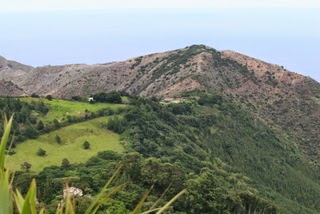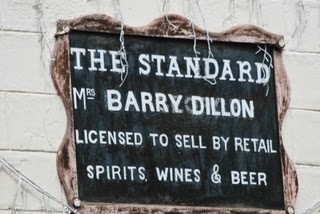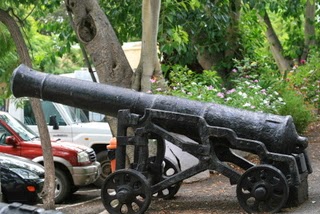 |
| All aboard 4pm....don't be late |
 |
| Small harbor boats |
 |
| Welcome RMS St. Helena, the local boat that comes monthly |
 |
| Fishing vessels of the locals |
 |
| The Castle on the left, seat of government since 1659 |
 |
| The RMS St. Helena |
 |
| Many cars, trucks, and taxis waiting for us |
 |
| Shoreline was rocky |
 |
| Amsterdam, not anchored, but kept in position by side thrusters |
 |
| Clean and clear waters, rocky shore |
As five star Mariners, we were able to board the aft tenderboat without getting the tickets in the Wajang. In fact, we could go anytime we wished, and by the time we did at 9:30am, there was no wait at all. The swells were pretty high, but the sailors made sure each and every one of us got into the boat safely. Around 9am, there was an announcement that all tendering was halted, due to failing engines on boat # nine. It had been on its way to shore fully loaded, then had to be hauled back. Glad we had waited to get off.
 |
| One of the first boats to get to the tender pier |
 |
| Our tender boat |
 |
| the Castle |
 |
| High wave action |
 |
| Local dove |
Anyway, we never set off with the idea of taking a tour today, but it just happened.. We had been advised that few, if any, taxis or private cars would be available for hire. But today, we saw more vehicles than we have ever seen. Most of the drivers were looking for groups of four to eight, but one smart fellow offered his services for the two of us for $20. per person. A private tour for 4 hours? A no-brainer. Our driver's name was Aubrey, born and raised in St.Helena, who had moved to Ascension Island for 25 years, then returned to his homeland for the last 21 years. We figured his age to be around the late 60's. He spoke perfect English, with a slight, but proper English accent. How lucky could we get?
 |
| Mary Ann with native guide, Aubrey |
 |
| Aubrey, our driver |
 |
| Looking back on the capital of Jamestown |
 |
| Heart-shaped waterfall |
 |
| Better view of the falls |
 |
| Very green hillsides |
 |
| Homes perched on hilltops |
 |
| Our ship in the distance |
 |
| Green meadows |
 |
| Many volcanic peaks |
 |
| Hillsides of Longwood canyon |
 |
| Very muddy, very slippery |
 |
| 1000 yard grassy walk to the tomb site |
 |
| The tomb |
 |
| Napoleon's Tomb site |
 |
| Deep blue morning glory |
 |
| Tropical setting with bananas, ferns, bouganvilla, and flowering plants |
 |
| Hillside of flowers |
 |
| Tiered gardens above the gravesite |
 |
| Walking back to the car |
 |
| Actually, an empty tomb since Napoleon was removed in 1840 |
 |
| The interviewer/photographer from the Sentinel newspaper |
 |
| This is the newspaper that we interviewed for |
Note to readers: We made the Thursday edition of the Sentinel Newspaper. Quite a surprise. Here is the link.
A brief mention of us is made here.
Well that was fun, and Aubrey seemed to like it too. Having lived most of his life here, we are sure everybody knows him and his family well.
 |
| Wind generators provide electricity |
 |
| A pair of white fairy terns in the center |
 |
| Cattle grazing |
 |
| Amsterdam in harbor |
 |
| A typical hilltop home |
 |
| Longwood House, home of Napoleon |
 |
| Gardens that surround the home |
 |
| Exit from the house to the gardens |
 |
| Orange daylilies line the exit |
 |
| Napoleon's home (actually prison)....not bad for a prison |
Before exiting the home, we signed the guest book, then entered the garden grounds. We estimated that this manicured garden surrounding the home was about 1/2 acre, which included an expanse of green lawn in front. If this was our abode, the gardens would be our favorite spot. Planted with dayliles, agapanthus, deep blue morning glory, daisies, geraniums, cockspurs pontsettias, and hibiscus, it was a lovely setting.
 |
| Rows of daylilies |
 |
| Cockspur blooms resembled bird of paradise flowers |
 |
| Blooming bouganvilla |
 |
| Yellow-flowering daylilies |
 |
| Garden guard house |
 |
| Purple bouganvilla |
 |
| Hyacinths in the lily pond |
 |
| Blooming lily |
 |
| Mary Ann lost in the garden |
 |
| Rock wall covered in morning glory |
 |
| This bloom will last one day only |
 |
| A type of amaryllus |
 |
| Orange blooms of a lily |
 |
| Fields of flowers |
Aubrey asked if we would like to see the golf course and the future airport being built. He said if you wanted to play 18 holes, then you would have to do it twice, since it is a 9 hole course. Makes sense to us. The greens were being mowed, but the roadside was being trimmed by tethered goats. In fact, when goats, sheep, cattle, and horses were introduced to the island by the Europeans, they eventually stripped the land of all vegetation and indigenous plants species.
 |
| Country road |
 |
| St. Helena's fire truck |
 |
| A tethered goat on the 9 hole golf course |
There are severe restrictions now, and conservation efforts have been successful in restoring the balance. Today pigs, sheep, goats, and cattle are ranched here. We did see a few donkeys out and about, but no horses. There are no large predators and no snakes or foxes, but there are feral cats, rats, and mynah birds that eat smaller wildlife, especially the birds and their eggs.
 |
| Volcanic peak |
 |
| Grazing sheep |
 |
| Valley used for the airport which may be Prosperous Bay Plain |
 |
| Much excavation still in progress |
 |
| Workers camp at the airport site |
 |
| Huge trucks working on the future airport |
 |
| Grazing sheep |
 |
| Terraced homes |
 |
| A tree marks the mountaintop |
Did we mention that the RMS St. Helena was also in the harbor today? This vessel sails with supplies and as many as 130 passengers from Cape Town to Ascension Island, then onto St.Helena once a month. Since there is no airport, all supplies and mail for the islanders comes via this ship.
 |
| RMS St. Helena |
 |
| Local mynah bird, import from Southern Asia |
 |
| Red-billed Tropic Bird |
 |
| The wirebird of St.Helena |
 |
| Flax-covered hillside |
 |
| Serene setting |
 |
| Nice home on bluff |
 |
| Acres of gardens surround this home |
 |
| Very pretty hillsides |
.jpg) |
| Dense growth |
 |
| Looking out over the South Atlantic Ocean |
 |
| Different varieties of trees |
 |
| St. Matthew's Church and cemetery in the valley |
 |
| Local store soon to be opened again |
 |
| Green hills from the recent rains |
The hillsides were dotted with dozens of small homes on small plots of land. They had solar water heaters, LP gas for cooking, electricity, gravity-fed water, and septic tanks. He estimated that each government-built house may cost about 50,000 pounds. Most all of the homes had dish TV, which residents pay for by the month...just like everywhere else in the world.
Driving around Diana's Peak at 2700 feet, we figured it was the tallest point of the island. Two spires loomed before us in the volcanic caldera...Lot and Lot's wife. The two large calderas created by volcanoes are now extinct.
 |
| Lot and Lot's Wife, volcanic spires on the left |
 |
| View as seen from on top of Sandy Bay ridge |
 |
| Volcanic hillsides may eventually be forested |
 |
| One of the beautiful valleys |
 |
| Volcanic peaks |
 |
| Looks like a moonscape |
 |
| Pinnacles |
 |
| View from Sandy Bay Ridge |
 |
| Sandy Bay valley |
 |
| The Plantation House |
 |
| One of the five tortoises |
 |
| Veggie garden for the home |
 |
| Jonathon "misbehaving" |
 |
| Miraculous at his age of 182 years old |
 |
| Information at the site |
On the bottom end of this paddock was a veggie garden used for the governor. Beyond that, the gardens were rented out to locals to grow crops. With the weather a constant warm temperature, they can grow all types of fresh produce easily. We also saw tree saplings planted by the Duke of Edinborough in 1957, and some planted by the Duke of York in 1984. They are screened so the tortoises cannot harm them. Further down the road, groves of eucalyptus trees and Norfolk Island pines had been planted. The pines were used for masts on the sailing ships in the old days, and these trees made the best and straightest ones.
The next stop was at Ladder Hill after driving through Half Tree Hollow. Love these names. Jacob's Ladder (meaning steps to heaven) is a landmark staircase here. Built in 1829, it has 699 steep steps straight up a mountainside to the island's fortress. Actually, these stairs were added later, because the original pathway was made for a horse-drawn sled.
 |
| Jacob's Ladder |
 |
| Crew members climbing it |
 |
| Very steep climb |
 |
| Aubrey and Mary Ann at the vista point on Ladder Hill |
 |
| View from the top of Ladder Hill |
In 2005, on our very first visit to St. Helena, we walked from the tender pier to the top of the ladder. Once at the top, we climbed down 6 steps, and took pictures.
 |
| This is the road we walked in 2005 |
 |
| Long way to town |
 |
| Much better in a car |
 |
| View of Jamestown in the gully |
 |
| Main street cuts through the center |
 |
| Boats looked tiny in James Bay |
 |
| The tenderboat landing near Rupert's Bay |
 |
| House on top |
 |
| Homes and businesses of Jamestown |
 |
| A guesthouse at Half Tree Hollow |
 |
| 699 stairs to the top |
Last year, we had gone to the Consulate Hotel on Main Street for beers. But since Barbara H. had highly recommend that folks go there, it was swarming with too many people. So we opted to walk down to Anne's Place, located above the nice Castle Gardens.
 |
| The Castle Gardens |
 |
| Anne's Place above the Gardens |
 |
| Blooming flowers |
 |
| How clever is this? |
 |
| Fragrant lily |
 |
| Much nicer than the hotel up the road |
 |
| Good hamburgers and even better beers |
 |
| Windhoek beer from South Africa |
 |
| Decorated cafe |
 |
| Checking out the stores on Main Street |
 |
| Old post office |
Ice cream sounded good at this point, but do you think we could find a store that sold them easily? We were eventually directed the to DVD store, where they served vanilla softies in cups. It was across the road from the Castle Gardens, so we found an empty bench and took our time with the sweet treat.
 |
| There's got to be an ice cream shop somewhere..... |
 |
| Solomon and Company, a big business owner here |
 |
| We like this one |
 |
| Come on in and take off a load |
 |
| Town's clocktower |
 |
| White Horse Tavern |
 |
| The Consulate Hotel |
 |
| The perfect cottage |
 |
| Coat of arms over the old archway entrance |
 |
| Archway entrance |
 |
| St. Helena's flag |
 |
| Crew members at the Castle entrance |
 |
| The wirebird over the entrance gate |
 |
| Cannon of the past |
 |
| Signage at the mule yard |
 |
| Creators of fine liquors |
 |
| The dock area |
 |
| Crew member having a busy, but wet day |
 |
| Waves were getting dangerous |
 |
| Old tires used to cushion boat landing |
 |
| Banks battery |
 |
| Back to the sailaway party |
 |
| Hors d'oeuvres anyone? |
 |
| Leaving the island |
 |
| Mighty waves |
 |
| We hope to come back again someday |
 |
| Lower town and upper town |
 |
| Jamestown |
 |
| The capital |
 |
| Nice end to a long day |